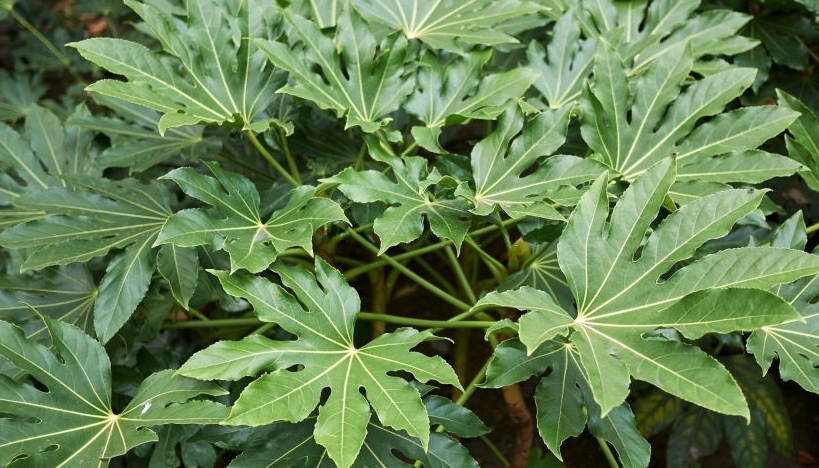Fatsia japonica leaves turn yellow mainly due to iron deficiency. Fatsia japonica leaves also turn yellow when the plant has been underwatered for too long. Yellow spots on the Fatsia japonica leaves are seen because of scale/aphid/mealybug or spider mite infestation.
Fatsia japonica is also called glossy-leaf paper plant/paper plant/false castor oil plant/Fatsi. The plant can be grown indoors and outdoors.
Fatsia is grown for its beautiful foliage. The plant is known for its rapid growth. Let’s see why the plant leaves turn yellow.
We shall also look at the ways to fix yellow leaves in Fatsia japonica.
Fatsia japonica Iron Deficiency
Fatsia japonica leaves turn yellow when the plant doesn’t get adequate Iron. The plant can’t absorb Iron when the soil is too alkaline. If the leaves are yellow but you can still see the veins then the plant lacks Iron.
That doesn’t mean Fatsia likes only acidic soils. Fatsia japonica grows fine in neutral soils. Check the soil with a pH meter.
There are ways to fix the alkalinity of the soil. You can amend your alkaline soil in the following ways.
- You can add sequestered iron to the affected soil to lower its pH.
- Adding a layer of peat mulch around your Fatsia japonica helps too.
- You can also decrease the pH of the soil by adding flowers of sulfur to the soil.
- Such amendments need to be done once a year in the spring season.
Note: Seaweed and Epsom salts raise the pH, so stop adding them to the soil if the soil is alkaline.
Underwatering
Fatsia japonica leaves turn yellow typically due to underwatering. Underwatered plant leaves turn yellow and crispy.
Fatsia japonica prefers moist soil that is not too soggy. Check the soil of your potted Fatsia often and make sure it’s just moist at all times.
Underwatered plants can not absorb enough nutrients, and thus turn yellow. Keep a soil moisture meter handy and check the moisture when in doubt.
Too much Sunlight
Fatsia japonica leaves turn yellow when the plant is moved into sunlight suddenly. Fatsia japonica
Fatsia japonica can grow in full sunlight but you need to acclimate the plant slowly to the conditions. Moving the plant suddenly causes sunburn.
If your Fatsia japonica has been growing indoors for a long time, slowly acclimate the plant to the external conditions.
Fatsia leaves turning Yellow and Brown
Fatsia japonica leaves turn yellow with brown edges when the plant is affected by fertilizer burn. Overfertilizing the soil leads to fertilizer burn in Fatsia Japonica.
Salt builds up in the soil due to overfeeding. Such salt buildup inhibits your Fatsia Japonica from taking up the needed minerals.
Contact the local universities and get the soil tested via their Cooperative Extension Service. They offer an affordable service.
If there is an excess amount of salt in the soil, water deeply to flush out the excess salts. Always water your Fatsia japonica thoroughly before and after feeding it.
Do not fertilize your Fatsia japonica for a month and see if the plant revives itself. I’ve seen this happen with my plants.
Fatsia japonica yellow spots
Yellow spots are seen on Fatsia japonica typically due to scale infestation. Aphids, Mealybugs, and Spider mites can also damage your Fatsia japonica eventually turning the leaves yellow.
Scale on Fatsia japonica
Small spots on the leaves of Fatsia japonica are due to a scale infestation. Scales attach to the lower side of the leaves.
As soon as you see yellow spots on the leaves, look at the undersides of the leaves. Do you see any insects that are attached to the leaves?
Scales love to suck the plant sap out of the Fatsia japonica leaves. Scale pests drink the plant juice and excrete honeydew.
Honeydew attracts various types of fungi, leading to sooty mold. Sooty mold is a black-colored fungal outgrowth that looks ugly on the plant.
Aphids on Fatsia japonica
Aphids are common pests of several indoor and garden plants alike. Aphid infestation distorts the leaves of Fatsia japonica.
Affected leaves curl up, making a hideout for these pesky pests. Aphids suck the plant sap from the leaves, turning them yellow eventually.
Aphids also secrete honeydew that attracts sooty mold. As soon as you see honeydew/sooty mold, check the curled leaves for pests and treat the plant accordingly.
Mealybugs on Fatsia japonica
Mealybugs are a type of scale insect that produce masses of white, cottony substance on the host plant. Mealybugs suck the plant sap out of the leaves.
They appear usually on the axils of the leaves and near the blossoms. Do not let the infestation go out of hand.
Spider mites on Fatsia japonica
Spider mites are tiny insects that produce webcasts on the host plant. Their presence on Fatsia japonica can be confirmed if you notice those webcasts.
A severe spider mite infestation can also turn the Fatsia japonica leaves yellow. Below are a few ways to get rid of all these insects from your Fatsia japonica.
How to get rid of pests on Fatsia japonica?
- Spray water forcefully on the affected plant/affected branches of the plant to dislodge the insects. This works when there are only a few insects on the plant.
- Pick them off with your hands as soon as you see them. This may seem like a lot of work but it’s worth the hassle as it’s natural.
- Spray Neem oil on the affected plant to eliminate these pesky pests.
- If the infestation is severe, spray Insecticidal soap on the affected plant. Spray the plant once per week until you get rid of them all.
I wish you a pest-free garden, Happy Growing 🙂

